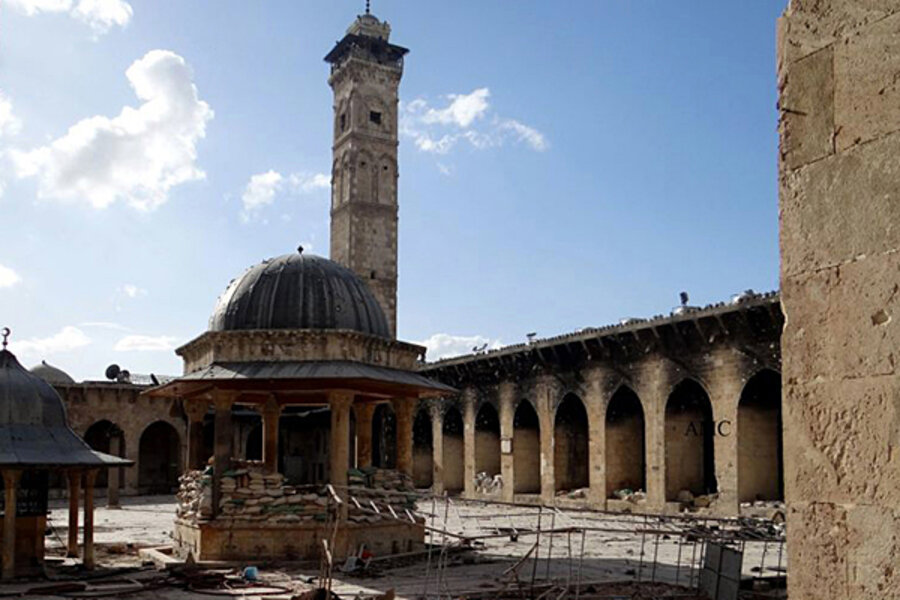Syria's ancient landmarks crumble under onslaught of war
Loading...
| Aleppo, Syria
This is an expanded version of a story that originally ran in The Christian Science Monitor Weekly.
Omar Islam has undertaken a Sisyphean task. In the midst of Syria's civil war, this former archaeology student with a master's degree in restoration work is braving sniper fire, artillery, and airstrikes to catalog the destruction of Aleppo's historical landmarks.
Today's battlefield was once a major tourist attraction. Aleppo's Old City is one of six places in Syria classified by UNESCO as a world heritage site and used to be one of the country's main attractions.
The recent loss of the minaret on the famous Umayyad Mosque has brought the threats facing historical landmarks here to outsiders' attention. The 11th-century mosque, however, is just one in a long list of ancient monuments damaged by the fighting – a list that includes two ancient markets, a library, several mosques, and historical bathhouses.
Activists have now collected photos and videos of the mosque, still very near the front line. Piles of rubble fill its courtyard, once known for its elaborate stonework. The five-level minaret, considered by many Islamic scholars to be among the most distinctive in the region, collapsed into a pile of stones indistinguishable from countless destroyed buildings.
The destruction is a blow to Syria's heritage and could be one to the postwar economy if it deters tourists, who accounted for 12 percent of the city's prewar economy.
"At this point, we can fix the damage and return the monuments to as they were before, but if the fighting continues like this we may lose some of these monuments forever," warns Mr. Islam, director of the Heritage Office at the Aleppo Administrative Council. “From my perspective, we have some very rare buildings. If we try to rebuild them, they won’t have the same feeling and spirit as before.”
Between 30 and 40 percent of the city's ancient landmarks have been damaged or destroyed since last summer. Heavy fighting prevents Islam and his colleagues from assessing several important sites.
"People working with these places and ancient things think that these ancient things have a spirit and a soul. Losing them is like losing a person," Islam says.
Those working to protect the sites say they hope some of the damage can be undone.
"Not all the damage is as bad as you'd imagine," says Abu Mahmoud, director of the Syrian Association for Preserving Heritage and Ancient Landmarks. "Even if the minaret [of the Umayyad Mosque] was destroyed, we are trying to save the stones so we can rebuild it the same as it was before."
Activists have also begun to worry about looting. The theft of artifacts has always been a problem in Syria, but with the vast majority of residents in Aleppo now jobless and the economy in ruins, the city has seen a sharp uptick in crime.
Several ancient texts, coins, a sextant, and a rare Quran are already among the items missing, but Islam says it’s impossible to tell if they were looted or destroyed.
Activists have tried to transport artifacts from on the frontline to safer areas, but this is difficult because they lack a car or a truck to transport the artifacts, let alone the specialized equipment needed to handle them properly.
Islam's group receives little outside support. He says he would like to reach out to UNESCO for help, but he doesn't have the slightest idea how to contact them.
For the residents who’ve continued to live in the Old City, the destruction of ancient landmarks is a troubling development but ranks below concern for their personal safety and the destruction of the city’s infrastructure.
“We have water tanks on our roof and if someone tries to fill his tank, snipers shoot at him,” says Abu Saleh, an unemployed truck driver who lives in the Old City. “My house has been destroyed by artillery fire, but there is no where safe to go in Aleppo.”
To date, Syria’s conflict has killed more than 94,000 people and displaced more than 1.4 million people as refugees outside Syria. No clear political solution has presented itself, and violence has only escalated in the past two years.
“Humans are important, but our history is the second most important thing. If we lose these monuments, we will kill our history,” says Hakyat al Shmal, a member of the Syrian Association for Preserving Heritage and Ancient Landmarks.





